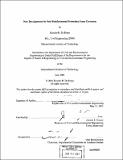New developments in steel reinforcement protection from corrosion
Author(s)
De Rojas, Ricardo R. (Ricardo Rafael De Rojas Pando), 1978-
DownloadFull printable version (7.323Mb)
Other Contributors
Massachusetts Institute of Technology. Dept. of Civil and Environmental Engineering.
Advisor
Jerome J. Connor.
Terms of use
Metadata
Show full item recordAbstract
Due to life-cycle costs considerations, the Federal Highway Administration has required that all their new bridge structures have a service life of more than 75 years. The practical use of adequate concrete cover, low water/cement ratio, and corrosion inhibitors and admixtures are not enough to satisfy this requirement. Corrosion still affects the reinforcing steel through the diffusion of chlorides. The steel reinforcement, the last line of defense, has to be addressed in order to protect reinforced concrete structures from corrosion and thus extend the service life. Today, new cost-effective technology has surfaced to address the problem. Nuovinox Stainless-steel clad reinforcing bars, fusion bonded epoxy (3M Skotchkot 426) and the recent Dual Phase Ferritic Martensitic bars (MMFXI/II steels) have emerged. This study describes each new reinforcement protection technology and compares them through cost, service life, availability and resistance considerations. The comparisons show that stainless-steel clad bars have the advantage over all other new reinforcement types. The fusion bonded epoxy closely followed while the MMFX steel, because of its lack of exposure, came in last. A prudent combination of the standard corrosion protection methods with these new technologies in steel reinforcement can potentially provide a cost-effective service of more than 75 years to a structure.
Description
Thesis (M.Eng.)--Massachusetts Institute of Technology, Dept. of Civil and Environmental Engineering, 2001. Includes bibliographical references (leaves 55-56).
Date issued
2001Department
Massachusetts Institute of Technology. Department of Civil and Environmental EngineeringPublisher
Massachusetts Institute of Technology
Keywords
Civil and Environmental Engineering.